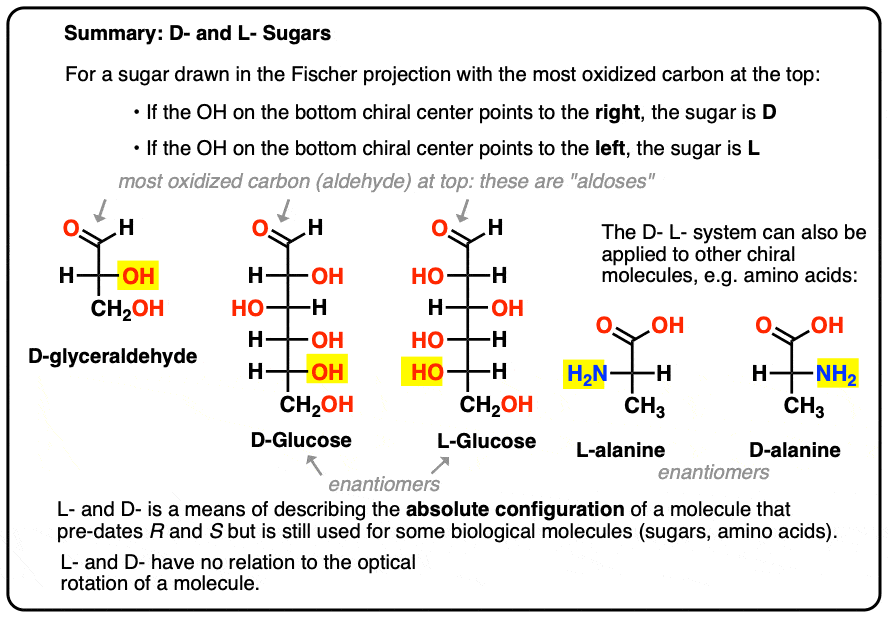

On the left side of the tested molecule, protons on 2'H and 3'H can couple only with L1, while on the right-protons 5'H and possibly 6'H are able to interact in a dipole with L2. Possible spatial interactions between the protons of L1 and L2 ligands and the monosaccharide are presented in (Fig. The consequence of observing the above-mentioned dipole coupling is the search for more Overhauser effects. Presence of this link indicates an inhibition of rotational freedom of connections around the glycosidic bond (Fig. The first diagnostic signal that should appear in the ROESY spectrum relates to the interaction in the 1'H/ 1H proton space. The general methodology for determining the configuration of secondary alcohols involves the search for a minimum of two diagnostic signals-homonuclear dipolar couplings.
#CHIRAL CARBON IN GLUCOSE REGISTRATION#
1):Įarlier studies on polyene macrolides and chiral probes with the use of the D-mannose scaffold allowed for the registration of dipole couplings, which appear most often between monosaccharides and aglycones 15, 16. Below, we have demonstrated the general concept of the proposed method (Fig.
#CHIRAL CARBON IN GLUCOSE SERIES#
The concept of the proposed method assumes a chemical synthesis related to the formation of an O-glycosidic bond between the probe and the aglycone, followed by a series of 2D NMR spectroscopic studies-including the observation of Overhauser effects between the protons of the carbohydrate units, alcohol units and the use of molecular modeling techniques to simulate the interactions of the created systems. The usefulness of the method can be checked on the proposed models of chiral secondary alcohols such as isomers (1S,2R,5S)-( +)-menthol, (-)-borneol and (S)-2-butanol. One of that bond’s component includes the tested asymmetric carbon. In the proposed concept, the sugar motif-in the case of 2-deoxyglucose-play the role of a stereochemically defined molecular probe introduced into a selected, chiral secondary alcohol by creating a bond. Therefore, in this study, we have examined the process of formation of tri-O-benzyl and tri-O-benzoil derivatives of 2-deoxyglucose and their application as chiral probes for elucidation of the absolute configuration of chiral secondary alcohols. While the general chemistry of this hexose is both compelling and not fully understood, it is known that the synthesis of beta glycosides of this monosaccharide is rather challenging 17, 18, hence beta-anomers by any means do not manifest as significant by-products of glycosidation process. In a constant search for the best possible sugar probe, our attention was drawn towards to 2-deoxyglucose. While in case of ( +)-menthol both alpha and beta anomers displayed diagnostic dipolar couplings, the formation of beta glycosides is generally being considered as a complication, which desimplifies the process of synthesis, isolation and NMR studies. Later on, tetra-O-benzyl derivative of D-mannose has yielded a successful stereochemical study on several natural compounds 16. In these studies, only the alpha anomers were proven to be useful. To this date, our group has proven the applicability of unmodified D-glucose, D-mannose and L-rhamnose for elucidation of the absolute configuration of 2-butanol 15.

While this is true for both alpha and beta anomers of resulting glycosides, in alpha anomers the pyranose probe settles itself closer to the aglycone, which enables an observation of diagnostic dipolar couplings in proton NMR spectra. Long story short, this approach is based on an observation that a glycosidic bond, formed between a pyranose and virtually any chiral aglycone, displays almost nonconformational freedom. It has originated from the model studies on amphotericin B its complete historical background has been presented in our previous. Some time ago, our group proposed a novel method of assigning the stereochemistry of secondary alcohols, which already echoed in the world literature 10, 11, 12, 13, 14. While still considered as a standard, this approach does not guarantee an unambiguous result, hence it is often burdened with dangerous assumptions, which may lead to erroneous conclusions 8, 9. This method, with dozens of its modifications, was used in studies of secondary alcohols and other classes of chiral molecules with limited success 2, 3, 4, 5, 6, 7. Several decades ago, Mosher and coworkers proposed a method for elucidation of the absolute configuration of secondary alcohols, which was based on the reactions of both enantiomers of MTPA with a studied molecule and careful observation of shielding/deshielding effects in NMR spectra 1. Secondary hydroxyl group is one of the most common, yet crucial functions found in natural and synthetic organic compounds, which-in most cases-introduce chirality to the molecule.


 0 kommentar(er)
0 kommentar(er)
